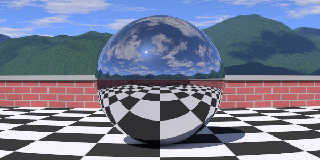|
 |
On 2018-08-04 07:33 PM (-4), Cousin Ricky wrote:
>
> TL;DR: I'm now working on very low detail mesh trees.
After a memory test, my priority has switched from revamping the trees
to implementing units.
First of all, I can't seem to find any memory usage statistics in the
POV-Ray 3.7 messages, so I did the test in 3.6. These are the results
for my original model, which uses a sphere for broadleaf trees and a
simple CSG intersection for conifers:
Smallest Alloc: 9 bytes
Largest Alloc: 492040 bytes
Peak memory used: 73732329 bytes
Total Scene Processing Times
Parse Time: 0 hours 0 minutes 55 seconds (55 seconds)
Photon Time: 0 hours 0 minutes 0 seconds (0 seconds)
Render Time: 0 hours 0 minutes 8 seconds (8 seconds)
Total Time: 0 hours 1 minutes 3 seconds (63 seconds)
These are the results of the mesh test:
Smallest Alloc: 9 bytes
Largest Alloc: 492040 bytes
Peak memory used: 85738823 bytes
Total Scene Processing Times
Parse Time: 0 hours 0 minutes 54 seconds (54 seconds)
Photon Time: 0 hours 0 minutes 0 seconds (0 seconds)
Render Time: 0 hours 0 minutes 9 seconds (9 seconds)
Total Time: 0 hours 1 minutes 3 seconds (63 seconds)
It appears that for low-detail models, there is near parity, at least in
POV-Ray 3.6, with the original system having a slight edge. A third
test with more complex CSG used a lot more memory, confirming that for
increased detail, meshes are definitely the way to go. But as long as
I'm not saving memory in the short term, the tree project doesn't seem
urgent.
Meanwhile, my patio is not wheelchair accessible. (What patio? Oh, I
forgot, in rig #4, I added an outdoor mode with a finite checkered
plane. Gotta have that checkered plane.) Of course, this is entirely
academic in a virtual universe, but if practical necessity were the only
factor, I wouldn't be worrying about hills and trees.
From the beginning of this 4th rig, I incorporated unit conversion
constants, because having a hardwired unit had already been a problem.
However, I haven't yet gotten around to integrating scaling factors into
the rig itself. In this state, the unit conversion constants are mostly
useless. This deficiency has reared its head in some of my Object
Collection projects, even though the rig itself is not part of the
uploaded scenes. When I added unit conversions to lrchairs (Leroy is
also an American, and his chair was sized accordingly), I had to fudge
the scaling in my test suite; and I had to do an unreasonable amount of
math to set the camera for the gem settings I posted last year. This is
work a prefab render rig should relieve me of.
I think I should best retrofit my existing code to incorporate
user-chosen units before embarking on a major project entailing
demolition and reconstruction of brick walls, or growing a new forest,
for that matter. As I see it right now, the horticulture can wait.
When the time comes, I am leaning strongly toward an increased triangle
count, without double illumination or interior texture. It turns out
that the current triangle count (95) leaves a disturbingly jagged
silhouette in the forest context, so I'd be going in that direction anyway.
Note: the hills in the attached image are just a textured height field.
Post a reply to this message
Attachments:
Download 'non-accessible.jpg' (103 KB)
Preview of image 'non-accessible.jpg'

|
 |




![]()